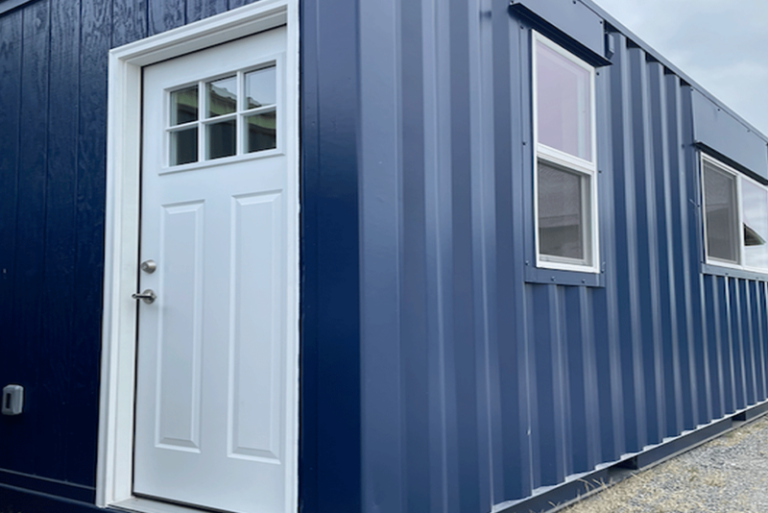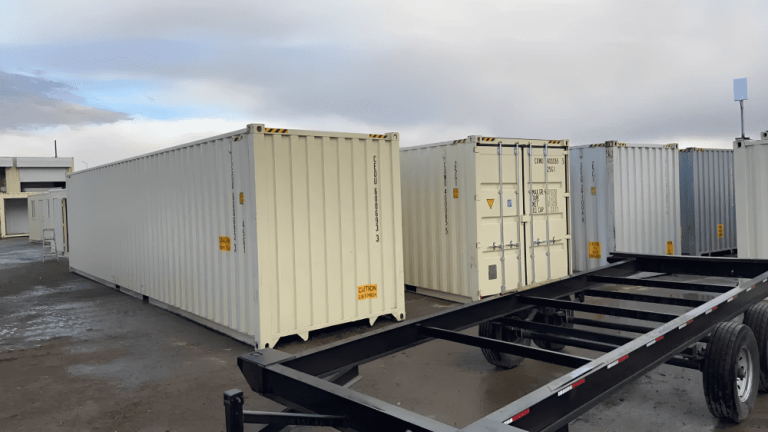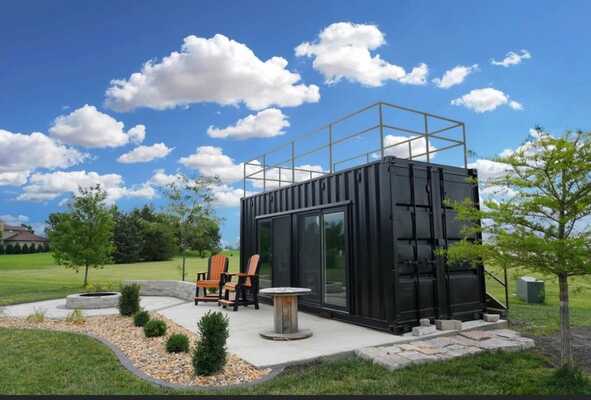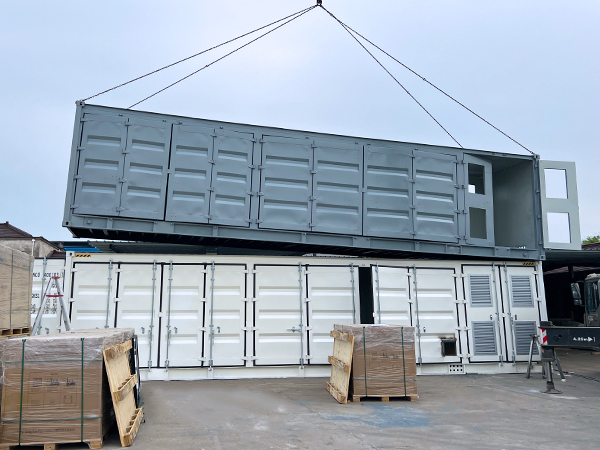Energy storage containers have become game-changers in 2025. These modular systems let you store and manage energy more efficiently than ever before. They’re not just about convenience—they’re critical for renewable energy integration and keeping the grid stable. Did you know the global energy storage market will have nearly tripled in size by 2023? By 2030, experts predict energy storage capacity will need to hit 1,500 gigawatts, with batteries making up 90% of that. This rapid growth shows how essential these systems are for a sustainable future.
Understanding Energy Storage Containers
What Are Energy Storage Containers?
(1)Definition and Purpose
Energy storage containers are modular systems designed to store and manage energy efficiently. They act as a bridge between energy generation and consumption, ensuring you have power when you need it most. Historically, energy storage evolved from methods like hydropower, which has been around for over a century, to advanced technologies that meet the demands of renewable energy sources. With the rise of solar and wind power, these containers have become essential for balancing energy supply and demand.
(2)Key Components and Systems
Every energy storage container includes several critical components. Batteries are the heart of the system, storing energy for later use. Power conversion systems manage the flow of electricity, ensuring compatibility with the grid or your devices. Advanced cooling systems prevent overheating, while fire suppression technologies enhance safety. Together, these systems work seamlessly to deliver reliable energy storage.
How Energy Storage Containers Work
(1)Energy Storage and Discharge Process
The process is simpler than you might think. Energy is stored in the container’s batteries during periods of low demand or high generation. When demand increases, the stored energy is discharged to power homes, businesses, or even the grid. Metrics like round-trip efficiency (RTE) and depth of discharge (DoD) measure how effectively this process works. For example, grid systems aim for an RTE of 80%, meaning most of the energy you store is available for use later.
(2)Integration with Renewable Energy Sources
Energy storage containers shine when paired with renewable energy. Solar panels and wind turbines generate power intermittently, but these containers store excess energy for use during cloudy days or calm winds. This integration ensures a steady energy supply, making renewables more practical and reliable.

Types of Energy Storage Containers
(1)Lithium-Ion Based Systems
Lithium-ion systems dominate the market due to their high energy density and efficiency. They’re compact, making them ideal for residential and commercial use. However, they require careful thermal management to prevent overheating.
(2)Flow Battery Systems
Flow batteries offer a unique advantage: scalability. You can increase their capacity by simply adding more electrolyte solution. They’re perfect for large-scale applications like grid storage, though they’re bulkier than lithium-ion systems.
(3)Emerging Alternatives
New technologies are on the horizon. Solid-state batteries promise higher safety and energy density, while sodium-ion batteries offer a cost-effective alternative. These innovations could redefine the future of energy storage containers.
Key Advancements in Energy Storage Containers in 2025
Battery Technology Innovations
(1)Higher Energy Density
In 2025, batteries in energy storage containers are packing more power than ever. Thanks to innovations like silicon anodes and high-nickel-content cathodes, energy density has reached new heights. This means you can store more energy in a smaller space, making these systems perfect for both homes and large-scale applications. For example, high-nickel cathodes not only boost energy density but also improve charging speeds. These advancements are critical for supporting renewable energy and ensuring a stable power supply.
(2)Faster Charging Capabilities
Nobody likes waiting, especially when it comes to charging. Advanced electrolytes and nanomaterials are speeding up the process, allowing energy storage containers to charge faster than before. Imagine being able to fully charge a system in half the time it used to take. Battery management systems also play a big role here, optimizing the charging process to make it quicker and safer. Faster charging isn’t just convenient—it’s essential for meeting the growing demand for renewable energy storage.
Enhanced Safety and Thermal Management
(1)Advanced Cooling Systems
Safety is a top priority for energy storage containers, and cooling systems have come a long way. Liquid cooling is now the go-to method, efficiently managing heat while using less energy. Immersion cooling, where components are submerged in a special liquid, is another game-changer. It keeps systems cool even under heavy use, ensuring they perform at their best without overheating.
(2)Fire Suppression Technologies
Modern fire suppression systems are smarter and faster. They use heat sensors and inert gas-based technologies to detect and address fire risks before they become a problem. These systems are designed to protect sensitive equipment without causing damage, giving you peace of mind when using energy storage containers.
Modular and Scalable Designs
Flexible Deployment Options
Modular designs make energy storage containers incredibly versatile. You can easily scale them up or down based on your needs. Whether you’re powering a small house or a large industrial facility, these systems adapt to fit your requirements. This flexibility is especially useful as renewable energy adoption grows.
Smart Grid Integration
(1)AI-Driven Energy Management
Artificial intelligence (AI) is transforming how you manage energy. It’s like having a smart assistant that constantly learns and adapts to your energy needs. AI algorithms analyze massive amounts of data, including battery usage and charging patterns. This helps optimize how your energy storage container operates. For example, AI can predict when to charge or discharge energy, ensuring you get the most out of your system. It also extends the lifespan of batteries by preventing overuse or unnecessary wear.
Head of Industrialization at a manufacturing head company, explains that AI combined with high-quality data is reshaping the energy market. Think about how AI revolutionized industries like healthcare and finance. Now, it’s doing the same for energy. By improving efficiency, AI-driven energy management makes renewable energy more practical and accessible for everyone.
(2)Real-Time Monitoring and Optimization
Imagine being able to monitor your energy system in real time. That’s exactly what modern energy storage containers offer. With real-time monitoring, you can track energy flow, battery health, and system performance from anywhere. This gives you complete control and helps you spot issues before they become problems.
Optimization takes it a step further. AI-powered systems adjust energy usage based on demand, weather conditions, and grid requirements. For instance, during peak hours, your system can prioritize stored energy to reduce costs. This dynamic approach ensures you’re always using energy in the smartest way possible. Real-time monitoring and optimization make energy storage containers not just tools but essential partners in managing your energy efficiently.

Challenges and Limitations of Energy Storage Containers
Even with all their advancements, energy storage containers face some challenges. Let’s dive into the key limitations you should know about.
Safety and Thermal Management
(1)Risks of Overheating
Overheating is one of the biggest concerns. When batteries operate at high capacity or during rapid charging, they generate heat. Without proper cooling, this heat can build up and damage the system. Advanced cooling systems help, but they’re not foolproof. You need to monitor these systems closely to avoid performance issues.
(2)Fire and Explosion Hazards
Battery fires are rare but serious. They can happen if the system overheats or if there’s a short circuit. Modern fire suppression technologies reduce these risks, but they don’t eliminate them.
Site and Environmental Constraints
(1)Space Requirements
Energy storage containers take up space. For residential use, this might not be a big deal. But for large-scale applications, you’ll need significant room. Urban areas, where space is limited, often struggle to accommodate these systems.
(2)Environmental Impact
The environmental footprint of these systems is another challenge. Manufacturing batteries requires mining rare materials, which can harm ecosystems.
Cost and Resource Challenges
High Initial Investment
Energy storage containers aren’t cheap. The upfront cost can be a barrier, especially for smaller businesses or households. While costs have dropped over the years, they’re still a significant investment.
Dependence on Rare Earth Materials
Many batteries rely on rare earth materials like lithium and cobalt. These resources are limited and expensive to extract. This dependence raises concerns about long-term sustainability and supply chain stability.
Here’s a quick look at some reports that analyze these challenges:
Understanding these challenges helps you make informed decisions about adopting an energy storage container. While the benefits are clear, addressing these limitations is crucial for long-term success.

Future Trends and Innovations in Energy Storage Containers
Next-Generation Battery Technologies
(1)Solid-State Batteries
Solid-state batteries are making waves in energy storage. Unlike traditional lithium-ion batteries, these use a solid electrolyte, which makes them safer and more efficient. You’ll love how they offer higher energy density, meaning they can store more power in a smaller space. This makes them perfect for compact energy storage solutions. Plus, they’re less prone to overheating or catching fire, which is a big win for safety. Researchers are also working on reducing their production costs, so they’ll soon be more accessible for everyday use.
(2)Sodium-Ion Alternatives
Sodium-ion batteries are emerging as a cost-effective and sustainable option. They use sodium, which is abundant and cheaper than lithium. Recent breakthroughs, like the development of bis-tetraaminobenzoquinone (TAQ) as a cathode material, have significantly improved their energy density. These batteries are ideal for large-scale applications, such as grid storage, because they’re affordable and environmentally friendly. With advancements like carbon nanotube binders enhancing electron transport, sodium-ion batteries are becoming a strong contender in the energy storage market.
Sustainability and Recycling
(1)Circular Economy Approaches
Energy storage is moving toward a circular economy. This means materials from old batteries are being reused to make new ones. By recycling components like lithium and cobalt, you help reduce waste and lower the environmental impact of manufacturing. Companies are also designing batteries with easier disassembly in mind, making recycling more efficient.
(2)Advances in Battery Recycling
Battery recycling technology has come a long way. Modern methods recover up to 95% of valuable materials, which can then be reused. This not only cuts down on mining but also makes energy storage containers more sustainable. As recycling becomes more advanced, you’ll see a significant reduction in the environmental footprint of these systems.
Integration with Emerging Technologies
(1)IoT and Blockchain for Energy Management
The Internet of Things (IoT) is revolutionizing energy storage. IoT-enabled systems let you monitor and control your energy storage container in real time. Imagine adjusting energy usage from your smartphone or having the system automatically optimize itself based on demand. Blockchain adds another layer by enabling decentralized energy trading. You could store excess solar energy and sell it to your neighbors, creating a more resilient and efficient energy ecosystem.
(2)Autonomous Energy Storage Systems
Autonomous systems are the future of energy storage. These use AI to manage energy flow without human intervention. They learn your energy needs and adjust accordingly, ensuring maximum efficiency. For example, during peak hours, the system might prioritize stored energy to save costs. Autonomous systems make energy storage smarter and more user-friendly, giving you one less thing to worry about.

Practical Applications of Energy Storage Containers
Energy storage containers are transforming how you use and manage energy. Let’s explore their real-world applications and how they’re making a difference.
Renewable Energy Integration
(1)Solar and Wind Energy Storage
When you think about solar and wind energy, their biggest challenge is inconsistency. The sun doesn’t always shine, and the wind doesn’t always blow. That’s where energy storage containers step in. They store excess energy generated during peak production times and release it when needed. This ensures a steady power supply, even on cloudy or windless days.
Here’s a quick look at the performance metrics that validate their efficiency:
| Metric | Description |
| Round-Trip Efficiency (RTE) | Measures how much energy you get back compared to what you store. Higher values mean less energy loss. |
| Coulomb Efficiency (CE) | Shows how effectively the battery stores and releases energy. |
| Depth of Discharge (DoD) | Indicates how much of the battery’s capacity you can use without affecting its lifespan. |
Other factors like storage capacity, duration, and cycle lifetime also play a role in making these systems reliable.
(2)Off-Grid Solutions
If you live in a remote area or want to go off-grid, energy storage containers are your best friend. They let you store energy from solar panels or wind turbines, giving you power independence. You won’t have to rely on the grid, and you’ll have a backup during outages. Plus, they’re compact and easy to install, making them perfect for off-grid living.
Grid Stability and Peak Shaving
(1)Load Balancing
Energy storage containers help balance the grid by storing energy during low-demand periods and releasing it during peak times. This keeps the grid stable and prevents blackouts. Advanced battery technologies, like lead-acid batteries, make this process more efficient. Data centers even use their underutilized storage capacity for grid balancing, turning a challenge into an opportunity.
| Evidence Type | Description |
| Grid Balancing Technology | Maintains grid frequency by using stored energy during peak demand. |
| Revenue Generation | Data centers can earn extra income by reallocating battery units. |
| Operational Considerations | Operators must ensure that grid balancing doesn’t disrupt core functions. |
(2)Emergency Backup Power
Imagine a sudden power outage. With an energy storage container, you’ll have a reliable backup. These systems kick in instantly, keeping your home or business running. They’re especially useful for hospitals, data centers, and other critical facilities where downtime isn’t an option.
Industrial and Commercial Use Cases
(1) Energy Cost Optimization
For businesses, energy costs can be a major expense. Energy storage containers help you save money by storing energy during off-peak hours when rates are lower. You can then use this stored energy during peak hours, reducing your electricity bills. They’re also easier to manage and maintain compared to traditional building-based solutions.
| Factor | Container Solution | Building Solution |
| Permitting and site constraints | Larger footprint, complex permitting issues | Smaller footprint, simpler permitting |
| Fire suppression | More complex deployment of suppression | Easier deployment of water-based systems |
| Weather mitigation | Less effective in extreme conditions | More effective in mitigating weather impacts |
(2)Supporting Electric Vehicle Infrastructure
As electric vehicles (EVs) become more popular, the demand for charging stations is skyrocketing. Energy storage containers are stepping up to meet this need. They store energy during off-peak hours and supply it to EV chargers when demand is high. This reduces strain on the grid and ensures a seamless charging experience for EV owners.
Conclusion
Energy storage containers are shaping the future of energy management. They’re making renewable energy more reliable and helping stabilize the grid during peak demand. In 2025, advancements like long-duration storage and smarter energy management systems will boost efficiency and flexibility. Companies are also focusing on eco-friendly production and recycling to meet sustainability goals.
Despite challenges like cost and safety concerns, innovation continues to push boundaries. Standardized systems and distributed energy networks are paving the way for broader adoption. As energy demands grow, these containers will remain essential for creating a cleaner, more resilient energy ecosystem.
FAQ
1. What makes energy storage containers different from traditional batteries?
Energy storage containers are modular systems designed for large-scale energy management. Unlike traditional batteries, they integrate advanced cooling, fire suppression, and AI-driven optimization. These features make them safer, more efficient, and scalable for various applications like grid stability and renewable energy storage.
2. Can you use energy storage containers in extreme weather?
Yes, you can! Modern containers come with weather-resistant designs and advanced cooling systems. They perform well in both hot and cold climates, ensuring reliable energy storage regardless of environmental conditions.
3. How long do energy storage containers last?
Most energy storage containers last 10-15 years, depending on the battery type and usage. Regular maintenance and smart energy management systems can extend their lifespan, ensuring you get the most out of your investment.
4 .Do energy storage containers work during power outages?
Yes, they do. Energy storage containers provide backup power during outages. They store energy in advance and automatically supply it when the grid goes down, keeping your home or business running smoothly.
MEOX equips your operations with secure, certified energy storage solutions. Our containers—built to BV and CE standards—feature fire-resistant materials, ensuring safety in extreme conditions. Whether powering renewables or stabilizing grids, we deliver reliability tailored to your needs.
Powering Your Future Safely.






